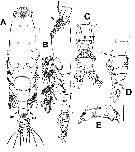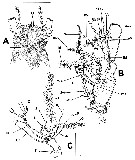
Issued from : E. Suarez-Morales & A. Castellanos-Osorio
in ZooKeys, 219, 876. [p.115, Fig.2].
Male (from: Chetumal Bay, Mexican Caribbean): A-B, habitus (dorsal); B, habutus (lateral; arrow indicates medial ventral protuberance); C-D, urosome (ventral and lateral; arrows indicate globular prcxesses on 5th pedigerous somite); E, genital complex with lappets (ventral view).
Scale bars: µm (A-B); µm (C-D); µm (E).
Nota: Cephalothorax robust, representing 47.5 % of total body length.
- Succeeding pediger somites 2-4 each with pair of biramous swimming legs; pediger somites 2-4 combined accounting for 31 % of total body length in dorsal view.
- Cephalic region wide, bilaterally protuberant in dorsal view, narrower than cephalothorax; outer margin of cephalic protuberances corrugate.
- Forehead weakly rounded, with coarsely rugose anterior margin and field of transverse striations on dorsal anterior surface; no other cephalic ornamentation discernible on dorsal anterior surface
- Pair of small dorsal pit setae between A1 bases; ventral anterior surface also with 2 pit setae.
- Cephalothorax dorsal surface with scattered dorsal pores.
- Midventral oral papilla moderately protyberant, located at about proximal 1/3 along ventral surface of cephalothorax.
- Pair of relatively small lateral pigment cups moderately developed, separated by length of less than one eye diameter, weakly pigmented; ventral cup slightly larger than lateral cups.
- Urosome consisting of 5th pediger somite, genital somite (carrying genital complex), 2 short, free pstgenital somites divided by incomplete dorsal suture, and short anal somite.
- 5th pediger somite with ventrally producede proximal half; dorsal surface smooth; distal half with pair of small medial rounded processes visible in lateral view ( arrowed in fig.2C, D); posterolateral margins of 5th somite produced, partially overlapping succeeding genital somite both dorsally and laterally (''ple in fig.2A, arrow in fig.2B).
- Genital somite slightly shorter than 5th pediger somite; genital complex of type I (
see Suarez-Morales & McKinnon, 2014<), represented by short, robust ventrally expanded shaft; complex with short, widely divergent lappets tapering distally into apical subtriangular opercular process (fig.2C-E.; lappets with rugose anterior surface, branches connectede medially by wide debntate margin.
- Anal somite 1.3 times as long as genital somite.
- Caudal rami subquadrate, approximally 1.1 times as long as wide and about 0.7 times as long as anal somite. Each ramus armed with 4 subequally long caudal setae.





